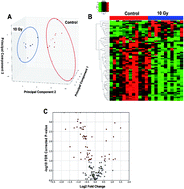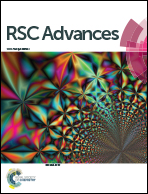Targeted metabolomics of nonhuman primate serum after exposure to ionizing radiation: potential tools for high-throughput biodosimetry†
Abstract
There is a need for research to rapidly determine an individual's absorbed dose and its potential health effects after a potential radiological or nuclear event that could expose large portions of a population to ionizing radiation (IR). Studies on biomarker identification after radiation exposure could aid in biodosimetry, identifying individual dose absorbed, as well as biologic response, and administering immediate and proper medical care. Metabolomics on easily accessible biofluids is an emerging field with potential for high-throughput biodosimetry. While tremendous effort has been put into obtaining discovery based global radiation signatures from a number of biofluids and model organisms, quantitative targeted analysis on a subset of known radiation biomarkers is required to develop an optimized panel of biomarkers for future clinical applications. The current study analyzes levels of several known broad chemical groups (acylcarnitines, amino acids, phosphatidylcholines, and biogenic amines) affected by IR in serum from nonhuman primates (NHP) 7 days after exposure through multiple reaction monitoring (MRM) analysis with a tandem quadrupole mass spectrometry (MS) platform. We identified several novel metabolites affected by IR exposure through univariate and unsupervised multivariate analyses. Levels of acylcarnitines, amino acids, and phospholipids were perturbed indicating altered protein metabolism, fatty acid β-oxidation, and inflammation. Fold changes in carnitine and short-chain acylcarnitines (acetylcarnitine, propionylcarnitine, butyrylcarnitine, and valerylcarnitine) complement previous global radiation signatures on NHP; notably, the levels of change were lower than previously observed in urine. Decreased levels of glutamate, citrulline, and arginine after IR are biomarkers indicating gastrointestinal syndrome and perturbations to the urea cycle. Sex differences were also assessed and were more prevalent in circulating acylcarnitines and phospholipids after IR exposure. These biomarkers may be combined with previously described compounds from DNA damage to develop a defined metabolomic biodosimetry panel to be analyzed by MS platforms, which are increasingly available in clinical laboratories.


 Please wait while we load your content...
Please wait while we load your content...